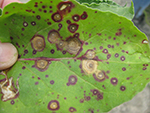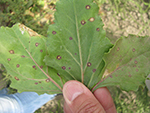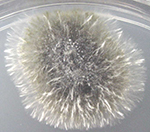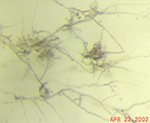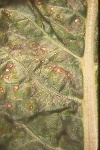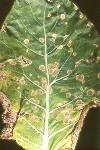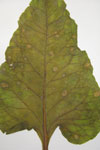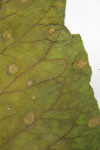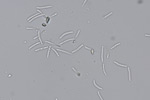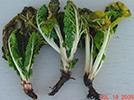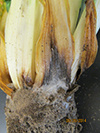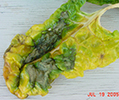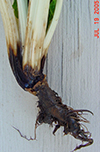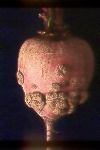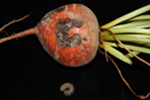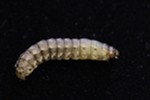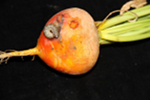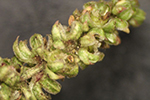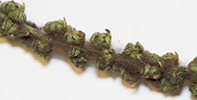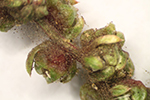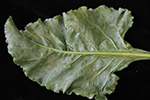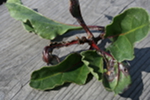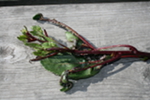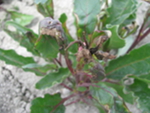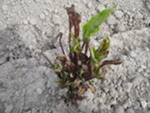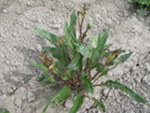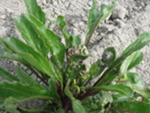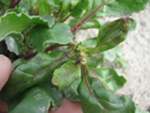Photo Gallery of Vegetable Problems
Beet
(Click on photo to enlarge)
Diseases
Disease: Phoma leaf spot and root rot
Pathogens: Phoma betae (Pleospora betae)
Host crops: Table beet, sugar beet, Swiss chard.
Online Resources:
https://pnwhandbooks.org/plantdisease/beet-red-beta-vulgaris-phoma-leaf-spot-and-root-rot
Disease: Powdery mildew
Pathogens: Erysiphe betae (= E. polygoni or Microsphaera betae)
Host crops: Table beet, sugar beet, Swiss chard
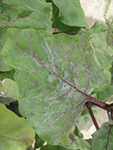 |
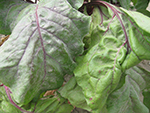 |
||
| Powdery mildew on a table beet leaf. | A table beet leaf infected with powdery mildew (left) compared to a non-infected lead (right). | ||
| Photo Source: Lindsey du Toit, Washington State University | |||
Online Resources:
https://pnwhandbooks.org/plantdisease/beet-red-beta-vulgaris-powdery-mildew
https://www.ipm.ucdavis.edu/PMG/r735100611.html
Disease: Ramularia leaf spot
Pathogen: Ramularia beticola
Host crops: Most vegetables in the Chenopodiaceae, i.e., sugar beet, table beet, and Swiss chard.
On-Line Resources:
Disease: Rhizoctonia basal petiole and crown infection
Pathogens:Rhizoctonia
Host crops: Many vegetables are susceptible to infection by Rhizoctonia spp., which are common soilborne fungi. In beet and Swiss chard, these fungi can infect the base of petioles and the crown or main root at or below the soil surface, particularly in moist soil conditions. During very wet conditions, infection can also occur on the leaves.
Online Resources:
Pacific Northwest Plant Disease Management Handbook
Disease: Rust
Pathogens:Uromyces betae
Host crops: Table beet
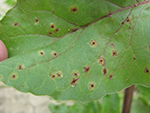 |
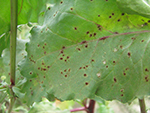 |
||
| Symptoms of rust on table beet. | |||
| Photo Source: Lindsey du Toit, Washington State University | |||
Online Resources:
https://pnwhandbooks.org/plantdisease/beet-red-beta-vulgaris-rust
Disease: Scab
Pathogen: Streptomyces scabies
On-Line Resources:
Insect/Mite Pests
Common names: Numerous aphids can infest vegetable crops, e.g., bean aphid, cowpea aphid, green peach aphid, melon aphid, and potato aphid.
Latin binomial: Numerous types of aphids including Aphis fabae (bean aphid), Myzus persicae (green peach aphid), Aphis gossypii (melon aphid), and Acrosiphum euphorbiae (potato aphid)
Host crops: In addition to beet, cucumber, corn seed, melon, potato, tomato, eggplant and pepper, aphids can feed on many other vegetables including broccoli, cabbage, spinach, Swiss chard, squash, pumpkin, as well as many weed species including Brassicaceae (cruciferous) weeds.
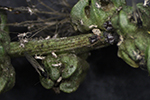 |
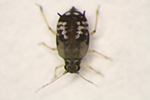 |
||
| Cowpea aphid infesting a table beet seed crop. | |||
Photo Source: Bev Gerdeman, WSU Entomologist |
|||
Online Resources:
Pacific Northwest Insect Management Handbook: Vegetable crop pests-Aphid
Common Insect & Mite: Aphids, Washington State University Hortsense.
Common name: Beet leafminer and spinach leafminer
Latin binomial: Pegomya betae and Pegomya hyoscyami
Host crops: Beet, spinach, sugar beet, Swiss chard, and many weeds including lamb’s-quarters, chickweed, and nightshade
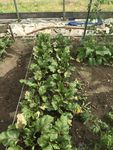 |
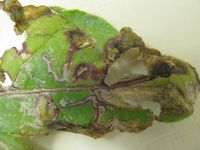 |
| Damage from beet leafminer | Damage from beet leafminer |
| Photo Source:
Kari Saunders |
Photo Source: Lindsey du Toit, Washington State University |
Online Resources:
Pacific Northwest Plant Disease Management Handbook: Beet, table-Leafminer.
Latin binomial: Various cutworms can feed on beets, e.g., Agrostis ipsilon (black cutworm), Apamea devastator (glassy cutworm), redbacked cutworm (Euxoa ochrogaster), army cutworm (Euxoa auxiliaris), spotted cutworm (Xestica c-nigrum), and variegated cutworm (Peridroma saucia).
Host crops: Wide host range, including many vegetables such as beet (sugar beet, table beet, fodder beet), bean, carrot, onion, spinach, potato, etc. Subterranean species feed on plant roots and stems, cutting the plants at the soil surface. Climbing species are nocturnal, i.e., they hide in the soil during the day and cut off plants at the soil surface or feed on new leaves and stems in the crown.
Online resources:
https://insect.pnwhandbooks.
Common name: Root aphid
Latin binomial: Pemphigus betae, Pemphigus populivenae
Host crops: Table beet, sugar beet, Swiss chard
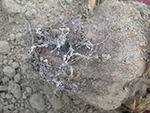 |
|||
| Root aphids on the root of a plant in a table beet seed crop. | |||
| Photo Source: Lindsey du Toit, Washington State University |
Online Resources:
https://insect.pnwhandbooks.org/agronomic/sugar-beet/sugar-beet-sugar-beet-root-aphid
https://www.ipm.ucdavis.edu/PMG/r735300511.html
Common name: Springtails (subterranean types)
Latin binomial: Order Collembola. There are numerous types of springtails or collembola, which are divided into two groups – subterranean springtails and surface springtails.
Host crops: Multiple vegetables, but most damage has been reported on spinach and beets, primarily in heavier, organic soils during very wet, cool spring conditions.
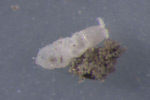 |
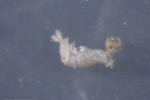 |
| A subterranean springtail extracted from soil in a spinach seed crop. | |
| Photo Source: Lindsey du Toit, Washington State University | |
On-Line Resources:
Springtails Springtails in Sugarbeet: Identification, Biology, and Management. North Dakota State University, Fargo
Control of Subterranean Springtails in Sugarbeet Using Granular, Liquid, and Seed Treatment Insecticides. North Dakota State University, Fargo
Springtail feeding on emerging crops (especially sugarbeet). Michigan State University
Pest: Springtail. Pest Spotter, Bayer CropScience
Also, see Swiss Chard: Springtails
Common name: Spider mites
Latin binomial: Tetranychus spp. including twospotted spider mite (Tetranychus urticae), strawberry spider mite (Tetranychus turkestani), and Pacific spider mite (Tetranychus pacificus)
Host crops: Wide host range, including many vegetables such as bean, carrot, spinach, potato, etc.
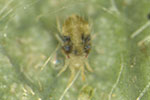 |
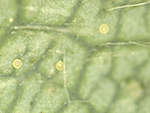 |
|
| Two-spotted spider mite adult and eggs on a potato leaf. | Eggs of the two-spotted spider mite, Tetranychus urticae. | |
| Photo Source: Silvia Rondon, Oregon State University | ||
Online Resources:
Carrot seed – Twospotted spider mite. PNW Insect Management Handbook, Chapter: Vegetable Seed, Section: Carrot Seed.
See Diseases, pests, and other problems common to many vegetables: Spider mites.
Managing spider mites in gardens and landscapes. University of California Online Statewide Integrated Pest Management Program.
Abiotic Problems
Herbicide Injury
Problem: Injury from application of specific herbicides to certain parent lines in seed crops, higher rates of application of some herbicides, or application of tank mixes (combinations) of some herbicides.
Crops affected: Some table beet and Swiss chard parent lines are more sensitive than others to injury by specific herbicides, even when these products are applied at recommended (labeled) rates; or injury can occur when higher rates of certain herbicides are applied to beet and chard crops; or injury may occur when certain herbicides are applied in tank-mix combinations.
Online Resources:
Herbicide Symptoms, University of California, Division of Agriculture and Natural Resources
Herbicide Modes and Action and Symptoms on Plants, Richard Smith, Farm Advisor, University of California Cooperative Extension.
Our pages provide links to external sites for the convenience of users. WSU Extension does not manage these external sites, nor does Extension review, control, or take responsibility for the content of these sites. These external sites do not implicitly or explicitly represent official positions and policies of WSU Extension.

